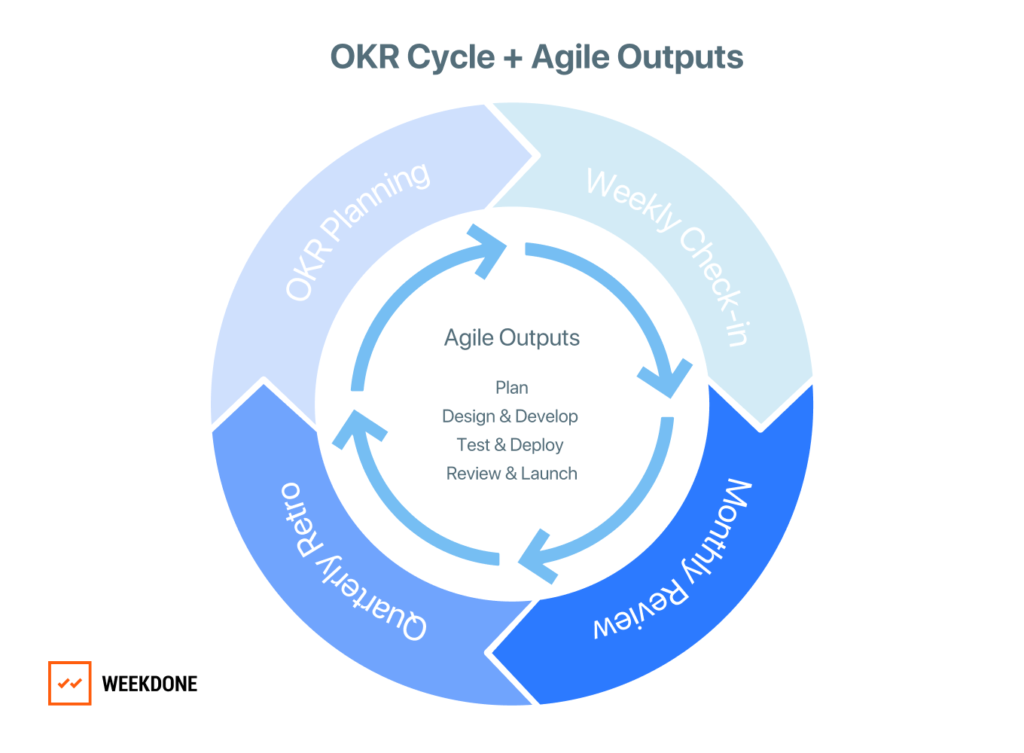There’s a lot of talk these days about agile frameworks and how to best utilize them in order to improve organizational efficiency. But what is often overlooked is the fact that agile frameworks can also be used in conjunction with Objectives and Key Results (OKRs). Agile frameworks and OKRs can work together to create a cultural shift within their organizations.
In this article, we’ll discuss the value of using both agile frameworks and OKRs in alignment, similarities and differences of each framework, and provide some tips and examples for making the shift.
The Meaning of Agile and OKRs
What is agile should be a question many business leaders ask themselves when trying to get the most from their team. Agile frameworks are designed to help organizations adapt to change quickly and efficiently. They are often used in software development but can be applied to any type of project.
In an agile methodology, projects are typically broken up into smaller phases and create more room for communication across multiple teams. Generally, agile methods follow a process of planning, executing, and evaluating.
Here are a few of the most common agile methodologies being used today:
- Scrum
- Kanban
- Lean development
- Extreme Programming
- Crystal
Objectives and Key Results (OKRs) are a framework for setting goals and measuring progress. They are usually implemented in organizations in order to improve performance and achieve objectives.
OKRs focus on setting a qualitative objective and measuring it with quantitative key results. These can be set at a company level, department / cross-functional level, and team level.
A cross-functional team OKR example – where multiple teams are contributing to impact the same outcome.
Objective:
- Increase our global efforts in retail
Key Results:
- Reduce customer wait time for shipments from 4 – 2 days
- Increase average online orders from 5,000 to 13,000 per month
- Generate more sales through influencer partnerships
Similarities of Agile and OKRs
Although OKRs are not a tool for project management in and of itself, combining both agile and OKR methodologies can create a powerful cultural mindset shift across the company.
Here are some of the similarities both methodologies include along with helpful tips on how to incorporate them into your business.
Adaptability + Flexibility
Both agile and OKR methodologies allow teams to be adaptable and flexible. In agile, this is done by breaking projects into smaller phases which makes it easier to make changes along the way.
Imagine your team has a goal to increase webinar sales by 30% in Q3. The entire quarter your team is working on the goal but you never actually check in to see how the team is progressing. There is no data to inform management whether or not the goal will be hit, you just hope for the best when the time comes.
Agile frameworks create many opportunities for your team to communicate about progress and make incremental changes to achieve goals.
In much the same way, OKRs also allows for adaptability and flexibility. The best way to think about OKRs is as a living document – they should be reviewed and updated regularly to ensure they are still relevant and achievable.
While agile frameworks keep your team adaptable while completing specific projects, OKRs help your team stay adaptable throughout long-term goals.
Brings Clarity and Focus
Because your team will be communicating more often when setting agile and OKR frameworks, it will help bring clarity and focus to your organization as a whole.
It can be easy for companies to get caught up in the day-to-day and lose sight of their long-term goals. But by utilizing agile frameworks, you can ensure that everyone is always aware of what needs to be done and why it’s important.
The same can be said for OKRs which help align goals across all departments and give a strong foundational goal to work from. Using both methodologies gives your team focus when working through campaigns but also throughout the year when achieving larger goals.
More Efficient Meetings
More communication breeds better clarity and focus in organizations, which ultimately helps team meetings function more efficiently.
Both frameworks place an emphasis on timely and effective communication, which will help reduce the amount of time spent in meetings.
Typical discussions in meetings that are used to clarify goals or align departments will no longer be needed. Instead, your company has time to focus on growth like sharing ideas or the lessons learned.
If you find that your team is spending more time than necessary in meetings, it could be a sign that you need to re-evaluate how your business is setting up and aligning goals.
Both agile and OKR methodologies can help with this by setting up clear channels of communication and giving everyone a shared understanding of the mission and goals of the company.
Differences of Agile and OKRs
While Agile and OKR methodologies include attributes that directly lead to company success, they do not function in the same way. Clear differences make them both different and necessary for company growth.
Below are the major differences between agile and OKR frameworks.
Output vs Outcome Goals
Inherent to agile frameworks is a focus on output. As a project management tool, agile frameworks are most concerned with what is being done day-to-day to complete a project.
The framework breaks down a project into smaller pieces and focuses on the tasks needed to complete the project. Each of these tasks is listed and then, depending on the system you use, tracked as progress continues. The entire organizational system is focused on tasks completed and what is being output by your team.
This is in contrast to OKRs which focus on outcomes. Rather than what needs to be done, OKRs are more interested in the results of what was done.
OKRs focus on goals and the direction of the company towards these goals. They use metrics to track progress and measure success, but they are simply tangible ways to tell if the system works.
Outcome goals can be more difficult to measure but are ultimately more important for company success. While it’s important to know what needs to be done, it’s more important to know if these actions and initiatives are actually leading to company growth.
Project Management vs Long-Term Mindset
As mentioned above, an agile framework is a project management tool. Its entire existence is to facilitate and track the completion of a project.
Different methods are used like Kanban, Scrum, and Crystal, but the overall process remains similar. Teams plan what needs to be done, track progress, and then reflect on what was learned. This process is repeated until the project is completed.
This is different from OKRs which take a long-term view of organizational success. OKRs are not for micromanaging individuals to make sure tasks are being done, but rather looks at the impact those actions revealed.
The framework itself is designed to help companies measure and hit specific goals. Objectives should be inspirational, and ambiguous – driving the teams to reach high.
What’s important is that there is progress toward that objective and it’s measured by key results. This progress shows everyone what worked and what didn’t. This system is designed for long-term success and not just the successful completion of a project.
7 Ways to Adopt an Agile Mindset With OKRs
Combining two separate methodologies and using them together to achieve company goals is easier said than done. First, you’ll need knowledge of how it has been successfully done in the past to replicate the results.
Below are the most essential tips for adopting an agile mindset with OKRs to lead your team to success.
1. Educate your team on the OKR methodology best practices
Your team won’t know how to properly align agile and OKR goals if you don’t inform them of the basics. Educate your team on what OKRs are and how they can be used to measure progress.
This doesn’t need to be a long, tedious process. A workshop to go over the basics will suffice. You can also provide resources like articles or books for those who want to learn more.
The important thing is that everyone is on the same page and understands how the two frameworks can work together.
2. Discuss the company vision with everyone
In the same way you need to educate your team on best practices, you also need to ensure everyone is aware of the company vision. This might seem like a no-brainer but it’s often one of the most overlooked steps.
Your team needs to know what the end goal is and how their daily actions can help achieve it. The company vision should be clear and concise so that everyone knows what they’re working towards.
If your team doesn’t know what the company’s goals are, they can’t possibly help achieve them.
3. Clarify active business metrics (KPIs)
Businesses have a lot of different metrics they need to track. These can range from website traffic to conversion rates. While it’s important to be aware of all these metrics, your goals should focus on a few specific metrics the entire team knows and is familiar with.
Aligning your team with the metrics they should be focused on ensures everyone is working towards the same goal and no actions are a wasted effort. This can be done by holding regular meetings to go over what’s important and what isn’t.
4. Keep focus on areas of improvement – don’t stray
It can be easy to get caught up in all the different aspects of a project and lose focus on what’s important. This is why it’s essential to have regular OKR check-ins with your team. These check-ins help ensure everyone is still focused only the most important things that will drive that impact.
There may be areas that need improvement in your business but won’t directly help the overall company goal. This is why it’s important for all teams to be involved and informed of company goals and contribute their own OKRs.
5. Remember your lessons learned
The key lessons your company is learning from using agile frameworks in combination with OKRs should always be logged for future reference.
Reiterating these lessons at weekly and quarterly meetings will help shift the cultural mindset within your company and embed the agile way of thinking.
Have someone at each meeting be in charge of capturing major lessons that have been learned from the agile and OKR processes. The more you integrate these lessons the more efficient the overall system will become.
6. Remove the “waterfall” top-down approach
Ignore the temptation to believe you or your management staff knows what’s best for all departments in your company. The “waterfall” top-down approach won’t work here. Be open-minded to new ideas and allow everyone to have a voice in the process.
Teams that are required to follow what management tells them often become frustrated and feel misunderstood. The miscommunication leads to dissent and a feeling of being undervalued.
In order to avoid this, allow your teams to set their own OKRs. If you have communicated the overall company goal, all other agile frameworks and OKRs will still align with the long-term vision.
Read more about how to run, facilitate and follow up on an OKR workshop
7. Provide the necessary tools to succeed
Your team is only as good as the tools at their disposal. To give them the best opportunity at success, provide them with all the resources they need. This might include access to certain software or databases.
Your team should also have a clear understanding of what’s expected of them and what resources are available to help them achieve company goals. If they’re unclear on either of these points, it will be difficult for them to succeed.
Seek feedback from your team at different meetings to see if the resources you provide are actually helping, or becoming more of a deterrent to achieving goals.
Agile OKR Examples
To get the most from your agile and OKR process, set an overarching company goal that informs the rest of the strategy. It’s also best to set agile OKRs on a quarterly cycle.
Here are some examples to follow when setting your own agile OKRs:
👉 Note: Agile tasks referred to below are example “Initiatives”. In Weekdone you can link Initiatives to Objectives and Key Results. See for yourself!
Company Goal
Expand our retail opportunities online to increase market share
Objective for Marketing: Improve visibility and quality of our website
Key Result 1 – Increase search volume to website from 11,000 to 25,000 average new users per month through SEO efforts
- Agile task 1 – Write and publish 10 new articles per week for high volume keywords
- Agile task 2 – Improve Ad copy on 6 campaigns by June 30
Key Result 2 – Improve click-through-rate by 5%
- Agile task 1 – Fix all CTAs in high volume articles to better match intent
- Agile task 2 – Create lead generation campaign and test different variations for 3 the quarter
Company Goal
Gain more market share in rural communities
Objective – Create a great membership program for clients in rural communities
Key Result 1 – Generate 40% more signups from target audience
- Agile task 1 – Set up 2 ads for target audience by Feb 1
- Agile task 2 –
Key Result 2 – Improve community engagement from 30 to 60%
- Agile task 1 – Prepare 10 webinar topics, outlines, and promotional materials by July 1
- Agile task 2 – Launch webinars on X platform by July 30th
Company Goal
Become a green friendly and sustainable company
Objective – Reduce our carbon footprint
Key Result 1 – Transition 75% of our production efforts to eco-friendly solutions
- Agile task 1 – Research and log all sustainable distribution companies by March 20
- Agile task 2 – Finalize deals with sustainable distribution company and make transfer by May 31
Key Result 2 – Achieve 80% completion of educational trainings on sustainability for our employees
- Agile task 1 – Create 6 week plan for employees with trainings and educational materials
- Agile task 2 – Form a 10 question survey on the course, distribute to employees who finished the course with 100% completion
Company Goal
Make Goodwill a bigger value in the company
Objective – Engage in new NGO partnerships
Key Result 1 – Generate 25% more contributions to non-profits
- Agile task 1 – Choose and reach out to 5 non-profits for partnerships
- Agile task 2 – Sign up for contribution platform by October 10
Key Result 2 – Increase # of NGO partnerships from 10 to 35
- Agile task 1 – Create 1 informative platform for NGOs to see and sign up to partner with us.
- Agile task 2 – Send email campaign to share platform with existing contacts
Company Goal
Get the company ready for online sales
Objective – Improve metrics related to a company sale
Key Result 1 – Decrease churn rate by 10%
- Agile task 1 – Add live chat to website by July 1
- Agile task 2 – Set up automatic welcome email by Jun 5
Key Result 2 – Increase CLV by 15%
- Agile task 1 – Add upsell page by August 3
- Agile task 2 – Redesign sales page by August 5
Start setting Agile OKRs today
Once you’ve set your agile OKR goals you’ll want a platform that makes it easy to track progress and make quick changes. The easier the system is for your team members, the more likely they are to follow it and integrate it into their daily activities.
Jira is a software that’s designed specifically for agile teams. It helps capture and prioritize issues, assign tasks, and track the progress of a project.
Weekdone OKR software gives you the ability to see how each team member is performing against their quarterly OKRs. They can additionally share weekly plans, progress, and report problems as they come up. Weekdone x Jira integration keeps your data centrally located for easy management.


